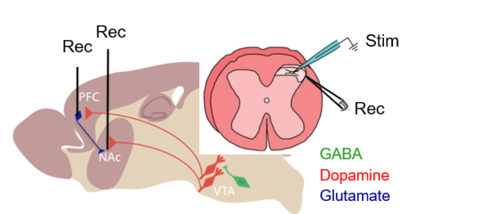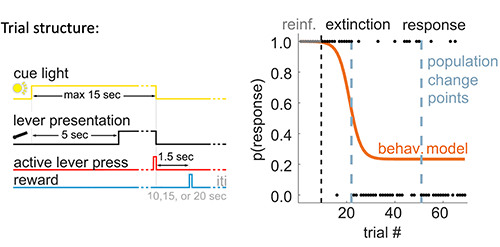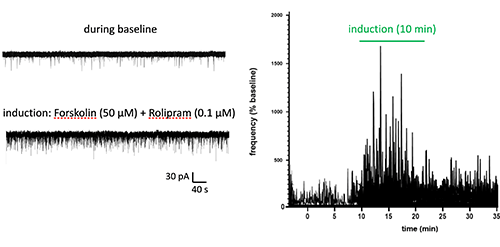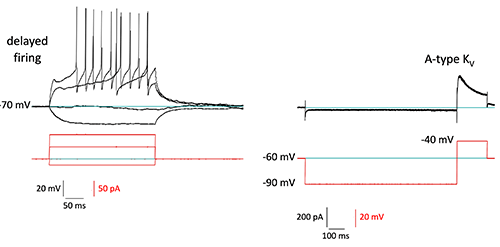You are here
Content
After 15 years of basic research at the MPI for Medical Research in Heidelberg, translational research has become another important aspect in Mannheim since 2013. Basic work on NMDA receptor subtypes in heterologous systems and glutamatergic synapses of the CNS was followed by studies on their functional modulation by dopaminergic and adrenergic transmitters mechanistically in acute brain slice preparations and in freely moving rodents during behavior.
Our work at ZI explored neurobiological mechanisms of addictive behavior (cocaine, alcohol, sugar) in rats during operant conditioning and extinction. With chronically implanted tetrodes (electrodes), arrays consisting of 32 or 64 channels, we record single-units (neurons) and local field potentials (LFPs) in 1-3 brain regions. The prefrontal cortex is always a target region, as it plays an essential role in the failure of self-control functions. Change points in behavior and neural activity during extinction of reward-seeking behaviors (Russo et al. 2021).
Skin or blood cells from patients with bipolar disorder and from carriers of a genetic polymorphism are reprogrammed into induced pluripotent stem cells (iPSCs) that differentiate into cortical or hippocampal glutamatergic neurons. We investigate disease-relevant mechanisms with the patch-clamp technique in 2D cultures and with multi-electrode arrays (MEA) in 3D cultures (brain organoids).
At the Chair of Neurophysiology we characterise chronic back pain originating in the periphery. In two rat models involving muscles/fascia (myofascial) or the intervertebral disc (discogenic), sensory pain thresholds during chronification are determined and intrinsic and synaptic activities in acute spinal cord slices are investigated.
Selection of current publications:
- Russo E, Ma T, Spanagel R, Durstewitz D, Toutounji H, Köhr G. (2021) Coordinated prefrontal state transition leads extinction of reward-seeking behaviors. J Neurosci. Mar 17;41(11):2406-2419
- Bertocchi I, Eltokhi A, Rozov A, Chi VN, Jensen V, Bus T, Pawlak V, Serafino M, Sonntag H, Yang B, Burnashev N, Li SB, Obenhaus HA, Both M, Niewoehner B, Single FN, Briese M, Boerner T, Gass P, Rawlins JNP, Köhr G, Bannerman DM, Sprengel R. (2021) Voltage-independent GluN2A-type NMDA receptor Ca2+ signaling promotes audiogenic seizures, attentional and cognitive deficits in mice. Commun Biol. Jan 8;4(1):59.
- Berberich S, Pohle J, Pollard M, Barroso-Flores J, Köhr G. (2017) Interplay between global and pathway-specific synaptic plasticity in CA1 pyramidal cells. Sci Rep. Dec 6;7(1):17040.
- Luís C, Cannella N, Spanagel R, Köhr G. (2017) Persistent strengthening of the prefrontal cortex - nucleus accumbens pathway during incubation of cocaine-seeking behavior.. Neurobiol Learn Mem. Feb;138:281-290.
- Li SB, Du D, Hasan MT, Köhr G. (2016) D4 receptor activation differentially modulates hippocampal basal and apical dendritic synapses in freely moving mice.. Cereb Cortex. Feb;26(2):647-55.
- Treviño M, Frey S, Köhr G. (2012) Alpha-1 adrenergic receptors gate rapid orientation-specific reduction in visual discrimination. Cereb Cortex. Nov;22(11):2529-41
- Astori S, Pawlak V, Köhr G. (2010) Spike-timing-dependent plasticity in hippocampal CA3 neurons. J Physiol. Nov 15;588(Pt 22):4475-88
- Scholz R, Berberich S, Rathgeber L, Kolleker A, Köhr G, Kornau HC.(2010) AMPA receptor signaling through BRAG2 and Arf6 critical for long-term synaptic depression. Neuron. Jun 10;66(5):768-80
- Kuner R, Köhr G, Grünewald S, Eisenhardt G, Bach A, Kornau HC. (1999) Role of heteromer formation in GABAB receptor function. Science. Jan 1;283(5398):74-7
- Köhr G, Eckardt S, Lüddens H, Monyer H, Seeburg PH. (1994) NMDA receptor channels: subunit-specific potentiation by reducing agents. Neuron. May;12(5):1031-40




